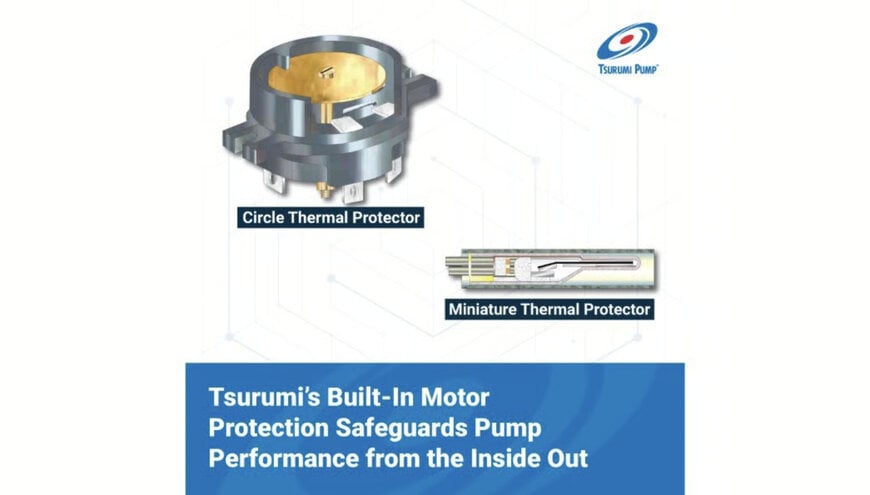www.ptreview.co.uk
25
'25
Written on Modified on
Tsurumi Pump Enhances Motor Safety with Advanced Built-In Protection Systems
CTP safeguards pumps up to 30 HP, while MTP protects 15–400 HP motors by detecting overheating and amperage issues automatically.
www.tsurumipump.com

Pumps often operate in demanding environments, where conditions can lead to overheating and motor failure. To prevent costly damage and downtime, Tsurumi Pump incorporates built in motor protection for all submersible pump offerings. Tsurumi’s Circle Thermal Protector (CTP) and Miniature Thermal Protector (MTP) are engineered to automatically respond to excess heat and amperage draw. Built in motor protection is essential, as it is not recommended to rely solely on overload protection when in ambient conditions.
CTP: Dual Heat and Amperage Sensing
Tsurumi’s CTP is used in small to mid-sized pumps up to 30 HP. It combines thermal and amperage protection into one compact housing unit, measuring approximately one to two inches in diameter. Inside, a bimetallic disc aids in maintaining an electrical connection between multiple stationary contacts, allowing electricity to flow through it and run the motor. However, when the air inside reaches a particular calibrated temperature, the disc snaps away from the contacts, cutting the power to the motor. The temperature typically rises as a result of the motor overheating or from excess amperage drawn from the heating element inside the CTP.
When the temperature returns to a particular reset temperature, the disc snaps back into the original position and reconnects the power to the motor. This allows the CTP to restart the motor without manual intervention.
By reacting to both excess temperature and amperage, the CTP protects the motors from damage caused by several operating issues:
- Locked rotor due to blockage or mechanical failure
- Phase imbalance
- Extended run dry conditions
- Single phasing in three phase units
- Low voltage
MTP: Thermal Protection for Larger Motors
Tsurumi’s MTP is used in larger three-phase motors ranging from 15 to 400 HP. During production, an MTP is embedded in each winding of the three-phase motor, totaling three MTPs. Each MTP is in close contact with the copper windings, allowing it to promptly respond to overheating, offering precise and responsive protection. All three MTPs are wired in the series and connected to a control panel relay. If any single winding exceeds safe operating temperature, the circuit opens, and a monitoring relay shuts off power to the pump.
For example, a 150 HP Tsurumi dewatering pump will normally have a motor with Class F insulation, rated for 311°F. The MTPs will trip at 302°F and reset at 185°F, significantly closer to the maximum temperature rating of the motor as they are embedded. In comparison, CTPs will not be as close to the maximum temperature rating due to a larger distance to the motor windings.
One Line of Defense
While CTPs and MTPs provide critical protection, they are part of a broader defense strategy against motor failure, which can include devices such as circuit breakers and seal fail sensors. Each factor acts as a symptom of an underlying issue, similar to a car’s check engine light. Immediate damage can be prevented, however if repeatedly ignored and reset without investigating the issue, failure will occur. Monitoring in combination with proper maintenance is therefore essential for long-term motor performance, ultimately minimizing the risk of unplanned downtime and expense.
www.tsurumipump.com
Tsurumi’s MTP is used in larger three-phase motors ranging from 15 to 400 HP. During production, an MTP is embedded in each winding of the three-phase motor, totaling three MTPs. Each MTP is in close contact with the copper windings, allowing it to promptly respond to overheating, offering precise and responsive protection. All three MTPs are wired in the series and connected to a control panel relay. If any single winding exceeds safe operating temperature, the circuit opens, and a monitoring relay shuts off power to the pump.
For example, a 150 HP Tsurumi dewatering pump will normally have a motor with Class F insulation, rated for 311°F. The MTPs will trip at 302°F and reset at 185°F, significantly closer to the maximum temperature rating of the motor as they are embedded. In comparison, CTPs will not be as close to the maximum temperature rating due to a larger distance to the motor windings.
One Line of Defense
While CTPs and MTPs provide critical protection, they are part of a broader defense strategy against motor failure, which can include devices such as circuit breakers and seal fail sensors. Each factor acts as a symptom of an underlying issue, similar to a car’s check engine light. Immediate damage can be prevented, however if repeatedly ignored and reset without investigating the issue, failure will occur. Monitoring in combination with proper maintenance is therefore essential for long-term motor performance, ultimately minimizing the risk of unplanned downtime and expense.
www.tsurumipump.com

